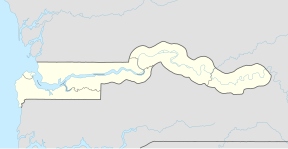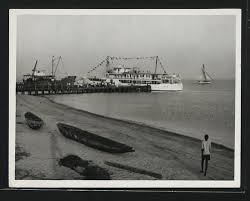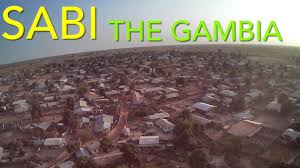Sabi Forest Park: Difference between revisions
No edit summary |
No edit summary |
||
| Line 24: | Line 24: | ||
[[File:Téléchargement (17).jpg|thumb]] | [[File:Téléchargement (17).jpg|thumb]] | ||
[[File:Téléchargement (16).jpg|center|thumb]] | [[File:Téléchargement (16).jpg|center|thumb]] | ||
| Line 43: | Line 44: | ||
==Ecosystem and Biodiversity== | ==Ecosystem and Biodiversity== | ||
Sabi Forest Park is characterized by a diverse range of habitats, including dense forests, wetlands, and savannah woodlands. This diversity supports a rich array of flora and fauna, including: | Sabi Forest Park is characterized by a diverse range of habitats, including dense forests, wetlands, and savannah woodlands. This diversity supports a rich array of flora and fauna, including: | ||
Colobus monkey in Sabi Forest Park] | |||
*Primates | *Primates | ||
•Western Red Colobus Monkey | |||
•Green Vervet Monkey | |||
•Patas Monkey | |||
Warthog in Sabi Forest Park | |||
*Mammals | *Mammals | ||
•Warthog | |||
•Bushbuck | |||
•Common Duiker | |||
Exotic bird in Sabi Forest Park] | |||
*Birds | *Birds | ||
•Abyssinian Roller | |||
•Yellow-billed Shrike | |||
•African Harrier-Hawk | |||
The park is also home to a variety of reptiles, amphibians, and a diverse range of insects. | The park is also home to a variety of reptiles, amphibians, and a diverse range of insects. | ||
| Line 68: | Line 80: | ||
*Picnic Areas: Designated picnic areas are available for visitors to enjoy meals and refreshments in the natural setting. | *Picnic Areas: Designated picnic areas are available for visitors to enjoy meals and refreshments in the natural setting. | ||
*Environmental Education: The park serves as a site for environmental education programs, engaging visitors in learning about the importance of conservation. | *Environmental Education: The park serves as a site for environmental education programs, engaging visitors in learning about the importance of conservation. | ||
Visitors exploring the Sabi Forest Park | |||
==Conservation and Research== | ==Conservation and Research== | ||
Sabi Forest Park is managed by the Gambia National Parks and River Parks Authority, with a focus on preserving the area's natural resources and biodiversity. The park also serves as a site for ongoing research and scientific studies related to the local ecosystems and wildlife. | Sabi Forest Park is managed by the Gambia National Parks and River Parks Authority, with a focus on preserving the area's natural resources and biodiversity. The park also serves as a site for ongoing research and scientific studies related to the local ecosystems and wildlife. | ||
Revision as of 14:23, 4 March 2025
Sabi Forest Park
Coordonnées : 13° 16′ 23″ N , 14° 12′ 2″ O

| Emplacement: | Upper River , Gambie |
| Ville la plus proche: | Basse Santa Su |
| Zone: | 73 hectares |
| Fondation : | 1er janvier 1954 |
| Visiteurs: | accessible au public |


Scenic view of Sabi Forest Park
Overview
The 73-hectare forest area is located in the Upper River Region (URR) in the Fulladu East district and, like the other Gambian forest parks, was created on January 1, 1954. It is located about five kilometers south of Basse Santa Su , headquarters of the URR administrative unit, and lies to the east of the road leading to the next larger town, Vélingara , in Senegal . Four kilometers further along the road, at the border, is the town of Sabi, which gave its name to the forest park. Sabi Forest Park is a protected forest area located in the Gambia, West Africa. It is known for its diverse ecosystem and serves as an important environmental and recreational site in the region.
Location
Sabi Forest Park is situated in the eastern region of the Gambia, approximately 100 kilometers from the capital city of Banjul. The park covers an area of around 1,500 hectares (3,705 acres).
Ecosystem and Biodiversity
Sabi Forest Park is characterized by a diverse range of habitats, including dense forests, wetlands, and savannah woodlands. This diversity supports a rich array of flora and fauna, including:
Colobus monkey in Sabi Forest Park]
- Primates
•Western Red Colobus Monkey
•Green Vervet Monkey
•Patas Monkey
Warthog in Sabi Forest Park
- Mammals
•Warthog
•Bushbuck
•Common Duiker
Exotic bird in Sabi Forest Park]
- Birds
•Abyssinian Roller
•Yellow-billed Shrike
•African Harrier-Hawk
The park is also home to a variety of reptiles, amphibians, and a diverse range of insects.
Visitor Facilities and Activities
Sabi Forest Park offers several visitor amenities and activities for tourists and nature enthusiasts:
- Hiking Trails: The park features well-maintained hiking trails that allow visitors to explore the different habitats and observe wildlife.
- Visitor Center: The park has a visitor center that provides information about the ecosystem and biodiversity, as well as guided tours.
- Picnic Areas: Designated picnic areas are available for visitors to enjoy meals and refreshments in the natural setting.
- Environmental Education: The park serves as a site for environmental education programs, engaging visitors in learning about the importance of conservation.
Visitors exploring the Sabi Forest Park
Conservation and Research
Sabi Forest Park is managed by the Gambia National Parks and River Parks Authority, with a focus on preserving the area's natural resources and biodiversity. The park also serves as a site for ongoing research and scientific studies related to the local ecosystems and wildlife.